In India, the rhododendron is the state tree of Sikkim and Uttarakhand, it is also the state flower of Nagaland. Locally known as Guraas[1]or Buransh[2] in the Himalayan region, these plants were extensively studied by Sir Joseph Hooker during his 1848-1850 visit to Sikkim (Singh et al, 2009). The word ‘rhododendron’ is of Greek origin, with ‘rhodo’ meaning rose and ‘dendron’ meaning tree (Bhattacharyya, 2011). Rhododendrons are ground-dwelling shrubs or trees, sometimes epiphytic[3], and often aromatic. They are the largest group in the Ericaceae[4] family with the greatest number of species. Among the eighty rhododendron species in India, thirty-nine are native to Sikkim, making the region a significant repository of rhododendron species (Lepcha et al 2008).
These primitive flowering plants hold considerable ecological and economic value, serving as a ‘keystone’[5] species whose disturbance can degrade habitats and threaten associated biodiversity (Singh et al, 2009).
These primitive flowering plants hold considerable ecological and economic value, serving as a ‘keystone’[5] species whose disturbance can degrade habitats and threaten associated biodiversity (Singh et al, 2009). It is also a food source for a wide range of animals, for instance, the rhododendron flowers sustain the community of insects, birds, and butterflies who are frequent pollinators. Rhododendrons also serve as climate change indicators due to their sensitivity to climate variations, with their buds serving as tools for monitoring global warming (International Rhododendron Conference, Sikkim 2010).
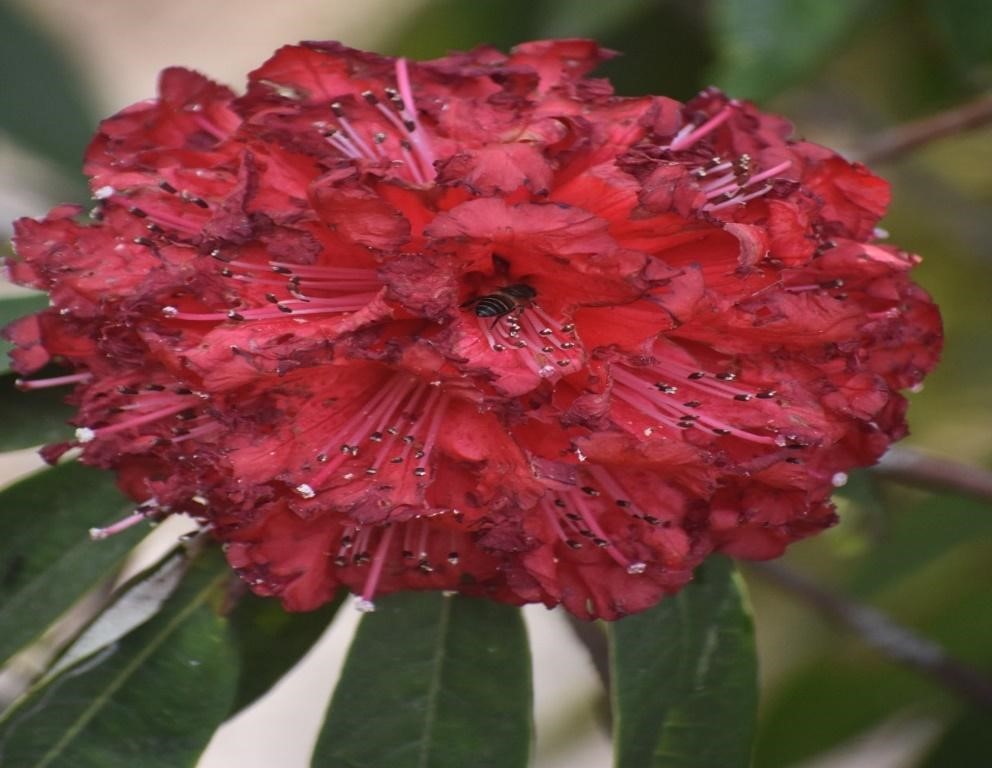
Photo: Priya Jadhav
Among the eighty rhododendron species in India, thirty-nine are native to Sikkim, making the region a significant repository of rhododendron species (Lepcha et al 2008).Villages rich in rhododendrons often host festivals to promote tourism and showcase local handicrafts and culture, highlighting the need to understand native people's dependency on these plants for future conservation efforts.
In the Himalayas, the blooming of rhododendrons heralds the arrival of spring. They grow at altitudes ranging from 1,500 meters to over 5,000 meters above sea level. These flowering trees renowned for their beauty, attract numerous nature enthusiasts (Pradhan, 2018). Additionally, various parts of the plant are used for medicinal purposes and other products, creating a dependency of local communities on these species for their social, cultural and economic needs (Singh et al, 2009). However, this dependence can pose a threat to the survival of these species. In Sikkim, the state government has established the ‘Barsey Rhododendron Sanctuary’ to protect and conserve the rhododendron species. Villages rich in rhododendrons often host festivals to promote tourism and showcase local handicrafts and culture, highlighting the need to understand native people's dependency on these plants for future conservation efforts.
The Multifaceted Uses of Rhododendron
In February 2020, I conducted a socio-ecological field survey in villages near the ‘Barsey Rhododendron Sanctuary’ in Sikkim. The study's main objective was to find the uses of the rhododendron and people's relationship with it. A preliminary survey of semi-structured interviews was conducted in Okhrey and Barsey to assess the reliance on rhododendrons and their increased demand during the tourism season. With the assistance of Mr. Passang Sherpa, who translated the interviews from Nepali to Hindi, we conducted interviews with 61 households. He helped make the participants understand my work, allowing me to gain their consent to interview them. The Sherpa community was particularly welcoming and shared their stories openly.
The rhododendron holds great significance for the local community. One resident shared, “We have been using Guraas for a long time. We chew its flowers to remove fish bones stuck in the throat, and sometimes just saying its name loudly can dislodge the bone.” Rhododendrons have been traditionally used by the local community, primarily for medicinal purposes (60%) and other general uses.
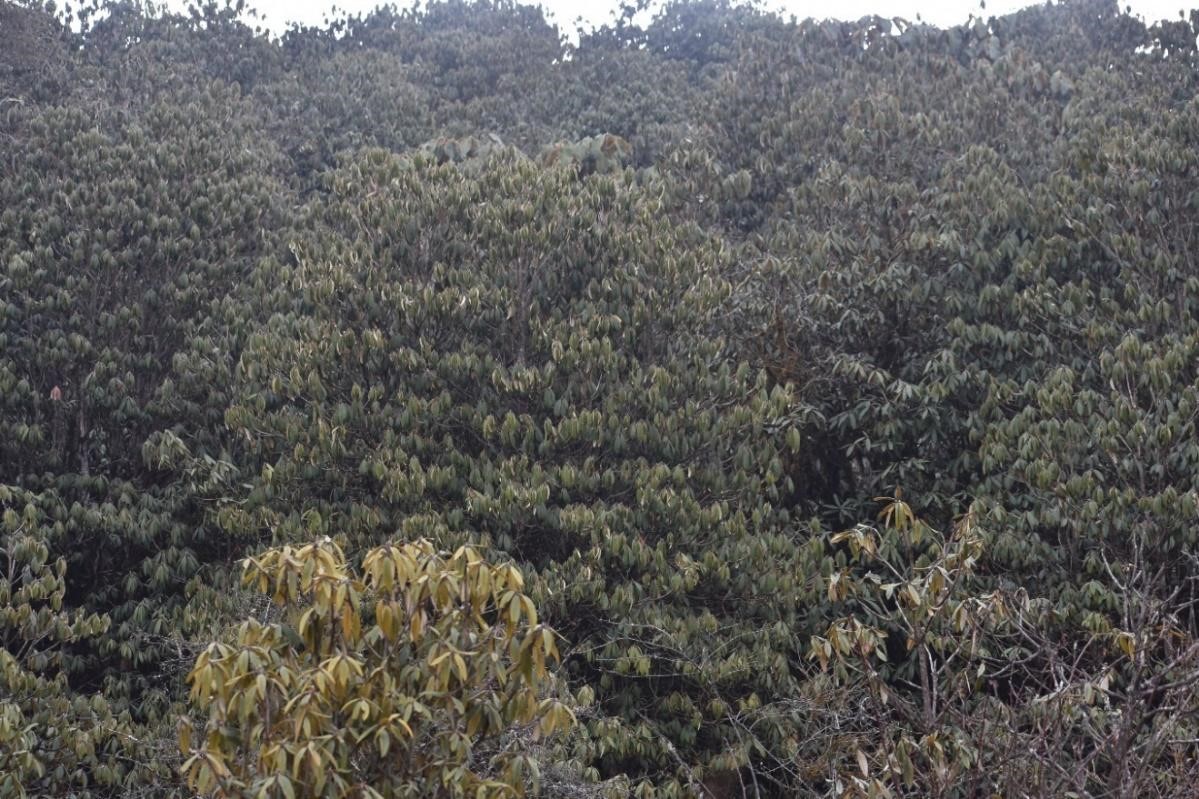
Photo:Priya Jadhav
In my research, I found that Sikkim is fully committed to organic farming, with agriculture contributing 35% to its economy and eco-tourism playing a significant role. Additionally, rhododendrons have been traditionally used by the local community, primarily for medicinal purposes (60%) and other general uses. ‘Rhododendron Arboreum’ is widely utilized being the first species found at elevations around 1800 meters, and is known as laali guraas[6] in Nepali. It also holds the Guinness Record for the 'World's Largest Rhododendron' and is widely popular for its medicinal benefits and economic value. The India Post issued a postal stamp in 1977 to commemorate this flower (Srivastava, 2011).
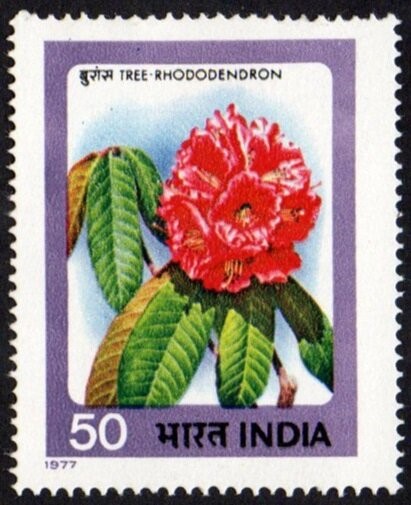
Credit: Blogger.com
‘Rhododendron Arboreum’ is widely utilized being the first species found at elevations around 1800 meters, and is known as laali guraas[6] in Nepali. It also holds the Guinness Record for the 'World's Largest Rhododendron' and is widely popular for its medicinal benefits and economic value.
Most rhododendron species are considered poisonous and are often avoided, but the local people have still found uses for them. For example, the flowers of the ‘Rhododendron Falconeri’ are said to be poisonous but their leaves are used in the packaging of ghee. The local people shared that the level of toxicity is lesser in its leaves which helps to keep the product moist and fresh so that it can be transferred for long distances.
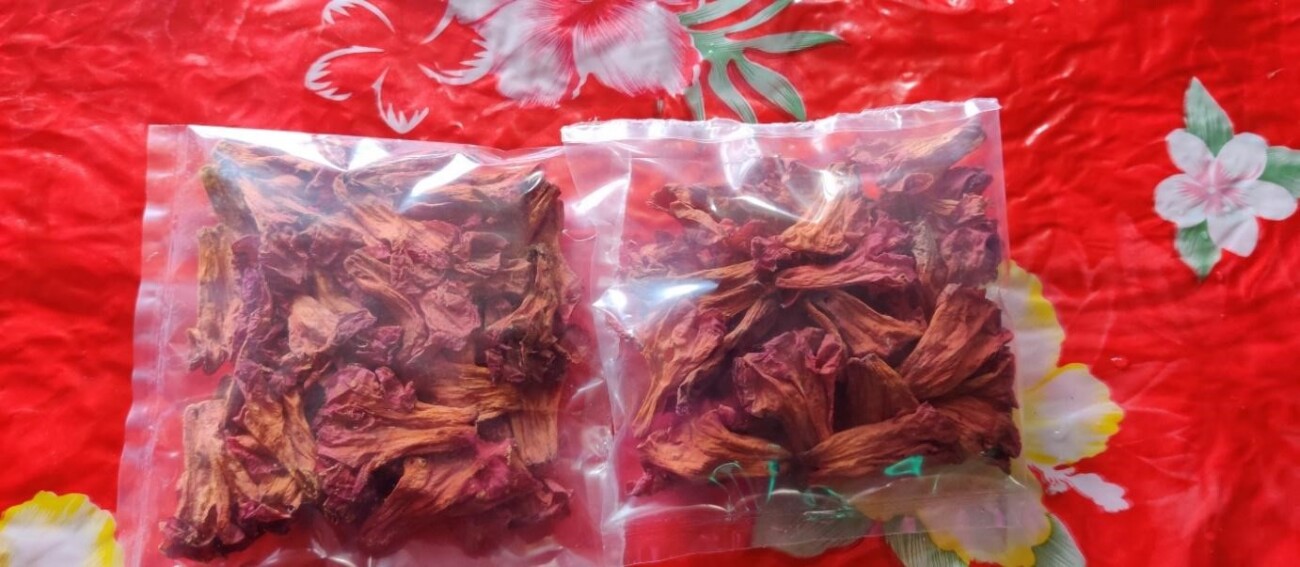
Photo: Priya Jadhav
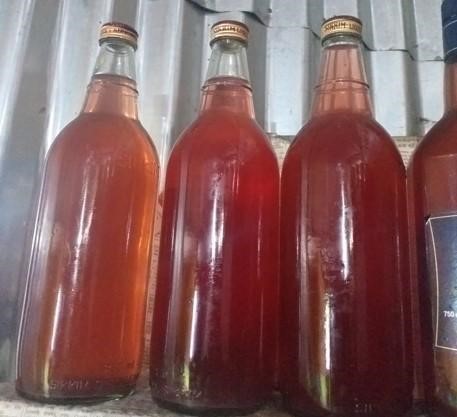
Photo: Priya Jadhav
The rhododendron holds great significance for the local community. One resident shared, “We have been using Guraas for a long time. We chew its flowers to remove fish bones stuck in the throat, and sometimes just saying its name loudly can dislodge the bone.” Tourists struggling with cold weather are often given fresh flower soup which also helps to alleviate altitude sickness. Another significant use of the Rhododendron Arboreum is in wheat farming; when a thorn pierces the skin and injects its poison, the boiled flowers are applied to the wound, and flower soup is given as an antidote. Rhododendron flowers are also used to make tea, which is said to aid in building a healthy body and digestive system. This tea is given to small children when they fall sick. Additionally, a paste made of rhododendron flowers known for its cooling properties is used to treat burns.
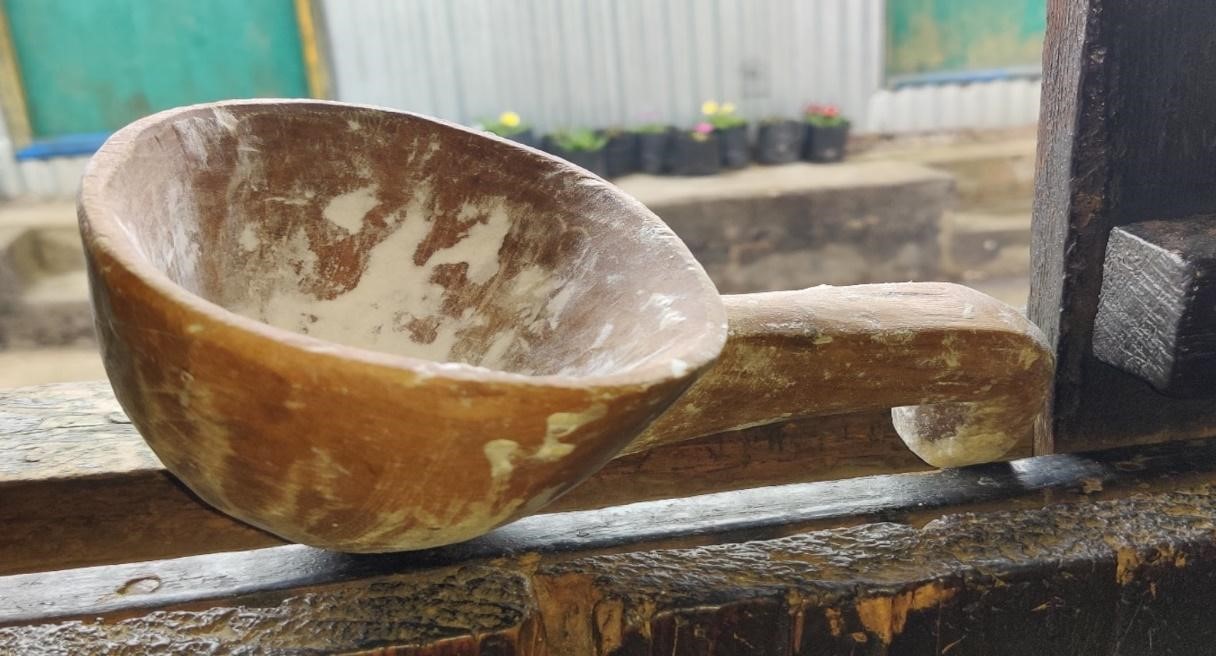
Photo: Priya Jadhav
A resident with furniture made from the rhododendron bark shared, “The cupboard in my house is made from the bark of the guraas from around 20 years ago. The wood is hard, lasts many years, and provides a shiny finish with good polish. Now, making furniture from rhododendrons is banned by the forest department.” The flowers and bark are also considered sacred offered during worship in temples and monasteries and used in various rituals. Around 60% of the people I spoke with claimed that fresh red rhododendron flowers treat fever, diarrhoea, and vomiting.
Community and Conservation
The sustainable use of rhododendrons presents more promising prospects for local livelihoods.For instance, Sikkim's ‘Barsey Rhododendron Sanctuary’ has provided new economic opportunities for the local people through tourism.
Sikkim is renowned for its rhododendron juice and wine, which are also believed to hold beneficial properties. These products should be given geographical recognition to highlight their value. I think this will help bolster the importance of the rhododendrons, which will encourage the local people to appreciate their value and take a greater interest in conserving them. The ability of residents to sustain themselves is closely tied to the collection of rhododendron blossoms, which are sold as fresh flowers or processed into juice. However, this activity is currently impacted by climate change. Also, limitations on the amount of flower collection should be practiced to maintain the species' survival in its natural habitat. In my 2020 research, a small percentage of Rhododendron Arboreum flowers were gathered from trees planted in some people's backyards, but most of the flowers came from people picking fallen flowers or gathering them from the forest. Approximately, 80-90% of the collected rhododendron flowers were made into wine and juice. The wine is one of the most popular products. The sustainable use of rhododendrons presents more promising prospects for local livelihoods. For instance, Sikkim's ‘Barsey Rhododendron Sanctuary’ has provided new economic opportunities for the local people through tourism.
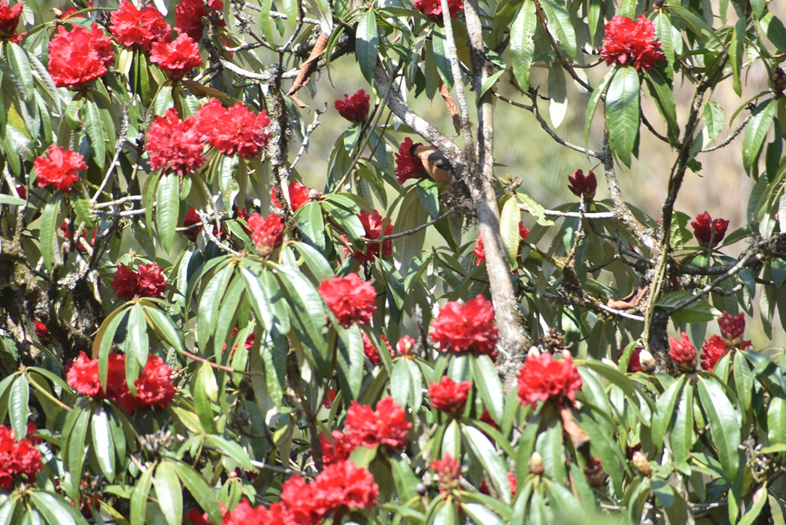
Photo:Priya Jadhav
This experience made me realize that with proper awareness and understanding, even small changes can help to foster coexistence with nature. After all, a region’s community plays a crucial role in conservation.
One of the most interesting moments during my fieldwork in ‘Barsey Rhododendron Sanctuary’ occurred during the basic household surveys. One of the questions I asked was, “Do you use solar energy?” The volunteer assisting me, Mr.Passang Sherpa who also runs 'Samdrup Homestay' in Okhrey, noticed this question and asked why I was inquiring about it. I told him about the importance of solar energy as a sustainable energy option. Shortly after due to the nationwide lockdown, I had to leave the state immediately. The best part of the day before my departure was when Mr Sherpa proudly showed me the newly installed solar lights in his homestay saying, “Now even our homestay is working towards sustainability.” This experience made me realize that with proper awareness and understanding, even small changes can help to foster coexistence with nature. After all, a region’s community plays a crucial role in conservation.
[1] Across Sikkim, Darjeeling, Kalimpong, and Nepal; the rhododendron is known as Guraas in the Nepali language
[2] In Uttarakhand, the rhododendron is known as Buransh
[3] A plant that derives moisture and nutrients from the air and rain and usually grows on another plant (Merriam Webster)
[4] The ‘Ericaceau’ is a family of flowering plants, commonly known as the heath or heather family, often growing in acidic and infertile conditions (Wikipedia)
[5] A species of plant or animal that is considered essential to maintaining optimum ecosystem function or structure (Merriam Webster)
[6] Laali Guraas means Red Rhododendron in Nepali
References:
- Bhattacharyaa, D. “Rhododendron Species and Their Uses with Special Reference to Himalaya – A Review. Assam University Journal of Science & Technology: Biological and Environmental Sciences. Vol. 7 Number 1: 161-167, 2011.
- International Conference RHODODENDRONS: CONSERVATION AND SUSTAINABLE USE. 2010. Forest Environment & Wildlife Management Department, Government of Sikkim, Gangtok, Sikkim, India.
- Lepcha L, Basistha B.C, et al. Understanding Significant Value of Rhododendron arboreum Smith Scarleti of Sikkim, India. International Journal of Engineering Science and Innovative Technology. Volume 3. ISSN: 2319-5967, 2014
- Pradhan, K. Rhododendron in the Sikkimese Himalaya, and the J.D. Hooker Chapter. Rhododendrons International Volume 2, 2018. Part 1 - Rhododendron Organisations in Countries with American Rhododendron Society Chapters the Online Journal of the World’s Rhododendron Organizations, 2018.
- Singh, K.K. Notes on the Sikkim Himalayan Rhododendrons: A taxa of great conservation importance. Turkish Journal of Botany. (33)4, 2009.
- Srivastava P. Rhododendron Arborium: An Overview. Journal of Applied Pharmaceutical Science 02 (01); 2012: 158-162
Priya Jadhav is a wildlife researcher with a master’s in 'Biodiversity, Wildlife Conservation, and Management' from Bhavan College, Mumbai. Her research focuses on the relationship between people and nature in ecology. Currently, she is working on a project at the 'Tadoba Andhari Tiger Reserve', where she studies local perceptions of large mammals and explores human-wildlife interactions.


Super article
It happened that while visiting to Khechiperi lake today my driver showed me this tree and explained that it’s a state tree . I took some photos but wanted to check the details of the tree as I love nature. I am glad I came across scientific study and information by you which has satisfied all my queries .
Let me know if you have site where I can find more such articles.
I found this article absolutely fascinating, and so well written. Will be reading it again, so that all the amazing details about the "Guraas/Buransh"(lovely names) stick in my head. And the next time I have a fish bone stuck in my throat (a regular occurrence!) I will think about this article!
Thank you so much! Glad you enjoyed it!
This is amazing! Kept me engaged from start to finish!
This is amazing! Kept me engaged from start to finish!
Thankyou so much!!
Got an insight on these fascinating trees, Never knew about their uses. Thanks for this article
Thankyou so much!!
Amazing read @Priya Jadhav. So much we got to know about these beautiful flowers and it's relationship with the local people!!
Thankyou so much!